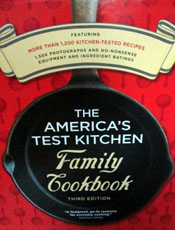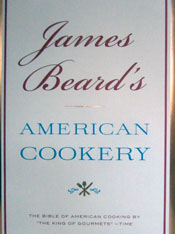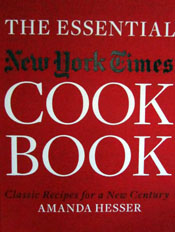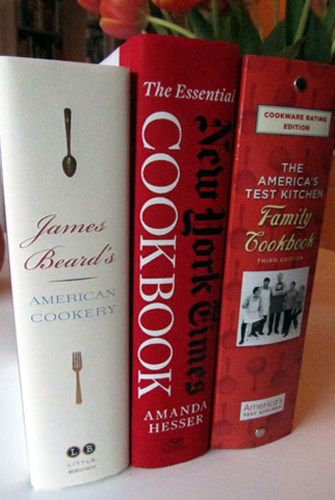Big Cookbooks
The fall is peak time for new cookbooks. Mine, included, which will be released in two weeks. But many others have been coming to my desk, some landing with a thud. Literally.
For some reason this seems to be a year of big cookbooks. I don't know if it has something to do with the economy but there are quite a number of these big volumes.
Three in particular stand out: The America's Test Kitchen Family Cookbook, James Beard's American Cookery, and The Essential New York Times Cookbook by Amanda Hesser. Taken together these three volumes have 2,556 pages, 4,700 recipes and weigh more than 7 pounds -- a bit intimidating for me whose book has 277 pages and only 92 recipes.
Heft is no measure of quality, but each of these cookbooks is both weighty and good, and each for different reasons.
The America's Test Kitchen Family Cookbook
The America's Test Kitchen Family Cookbook, from the editors at America's Test Kitchen ($34.95, hardcover, Boston Common Press), arrives as a disassembled three-ring binder. You put the book and its 728 pages and chapter tabs together, which takes about three minutes to do; not a big deal and you end up with a pristine volume that's yours to dent, stain and make yours. This book is what we have come to expect from Chris Kimball's crowd of cooks, testers and writers: it's comprehensive, crisp, practical, and useful.
There are 21 chapters organizing its more than 1,200 recipes plus the tips and advice that are usually found in America's Test Kitchen books -- about equipment, ingredients, and keeping a home kitchen. Its approach and point-of-view is family-friendly and the recipes are pan-American, many made with lower cost ingredients and flavors with a broad appeal, including fried chicken, nachos, lasagna, cobb and Caesar salads, reuben sandwich, egg drop soup, stuffed bell peppers, baked ziti, roast lemon chicken, whoopee pies, and Weeknight Skillet Fajitas made with Flank Steak, which we've been given permission to share with you. See our link.
Noting how busy people cook, there is an entire chapter dedicated to slow cookers and pressure cookers. And the recipes are taste-eclectic; for instance, the chapter on salads has 18 different dressings: Catalina, orange-sesame, blue cheese, creamy garlic, ranch, green goddess, and others. See our link to their recipe for Ranch Dressing, including a lowfat version.
While I think it's possible that the details on kitchen equipment and ingredient ratings can easily become dated, I've always loved how the folks at America's Test Kitchen encourage us to be discerning about all our cooking choices so this is a minor quibble.
This book is a good choice for the new cook, or as a housewarming gift for a young couple in their new home, or for families with kids trying hard to get everyone together around the table a few nights a week.
James Beard's American Cookery
James Beard, who died in 1985 at the age of 81,was the most acclaimed food writer of his time. He influenced generations of chefs, food writers, farmers, home cooks, and many of us who eat.
Beard wrote 21 books and James Beard's American Cookery ($35.00, hardcover, Little, Brown & Co.) is about American regional cooking. Originally published in 1972, this new 896 page volume is exactly as Beard wrote it, with the addition of a new foreword by chef Tom Colicchio, a fitting choice for putting Beard's legacy and recipes into a contemporary context.
Beard described this book as "…a record of good eating in this country with some of its lore." Along with more than 1,500 recipes, he gave us cooking's history, anecdotes, and changes across the American landscape. If you are remotely interested in food as culture, you will enjoy this book as something to read as much as cook from.
Still, it belongs in a kitchen. Its 28 chapters include one dedicated to ham and bacon -- recognizing the importance of these foods in regional cooking. There's also a chapter just on potatoes and another on pickles and preserves. And in his vegetable chapter he gives multiple variations for each, as with mushrooms: steamed, sautéed, with dill, with herbs and cream, deviled, broiled, stuffed, mushroom and potato pie, and under glass.
Less eclectic, we have his recipe for Navy Bean Soup, which many consider still to be a classic. See our link.
Beard seemed to really love this book and there is exuberance throughout, from the introduction to the reading list at the end. He often makes references to those who created a recipe or shared it with him; sometimes these would be celebrities from Beard's era, such as actor Alfred Lunt, but equally it could be someone like Mrs. Burgess of Webster City, Iowa, for a cheese soufflé.
He foresaw changes that in 1972 may have been unfathomable, between what he called technology and tradition. "While I do not overlook the grotesqueries of American cooking, I believe we have a rich and fascinating food heritage…."
Because we've changed some of our views toward certain ingredients, such as lard in pastries, we can be distracted from the hugely useful and coaching information that's throughout the book. That would be unfortunate because much of which he has captured in this volume is timeless. As was he.
The Essential New York Times Cookbook
The Essential New York Times Cookbook ($40.00, hardcover, W.W. Norton & Company) is not a re-issue of the Craig Claiborne classic. Instead it is something new and inspiring by Amanda Hesser, one of my favorite food writers.
With more than 1,000 recipes on 932 pages, this volume is a curatorial tour de force. An astutely edited collection of food writing and recipes culled from more than 150 years of archives at The New York Times, this book makes the case for why we still need cookbooks and not just internet archives since Ms. Hesser's voice and discretion add as much value as the recipes themselves.
Filling this book are recipes from contemporary food writers, cookbook authors, and chefs, as well as ones from decades past. The book also serves as a kind of cultural lens through which we can look back and see how food changed in our lives.
But as much fun as this book is to read, it is also one to cook from and I suspect that only Ms. Hesser could have turned something with so many high notes (all those pages! all those recipes! all that history!) into something truly friendly, useful, and modern. The book does not have a whiff of encyclopedia to it, despite its doorstop bigness. Instead it's a book to get dusted with flour and stained with pan splatters.
This is entirely due to Ms. Hesser's skill as both a writer and home cook for it seems she has cooked her way through decades of Times food sections. Her voice is always present, sometimes funny, always trusted, offering tips for what to expect. She also seems aware of how home cooking fits in a life -- maybe not neatly, but always with appetite.
There are 18 chapters, from Drinks, Cocktails, Punches, and Glogg to Pies, Tarts, and Other Desserts, and in between there's everything else you'd expect. My one squabble with the book is something that probably couldn’t be avoided and that is how the recipes are organized within each chapter: they're in chronological order. For example, in the Breakfast and Brunch chapter, it begins with "German Toast" from a Times' 1875 article, and finishes with a 2009 recipe by Mark Bittman for "Coconut Oat Pilaf." Because the recipes don't cluster around a main ingredient as typically done, it's sometimes confusing.
Plus many of the recipe titles are from when they appeared in the Times so they often have non-descriptive information, such as the recipe author's name or their restaurant of origin.
From a practical, I'm-searching-for-something-to-make-for-dinner-with-these-chicken-breasts utility, this format can be frustrating and demands a good index. The good news is that there is one.
The book's historic perspective adds a kind of backward-looking social commentary, added to by the fact that the Times was often capturing a moment or a trend. That's why you'll find recipes for such cultural touchstones as turducken and Junior's cheesecake.
The chapter on hors d'oeuvres, snacks, and small dishes includes Edamame with Nori Salt, Russ & Daughters' Chopped Chicken Liver, and Pork Belly Tea Sandwiches -- plus 134 other recipes. Yes, there are 138 recipes in just this chapter. We've been given permission to share one of the most tempting with you, Julia Reed's Hot Cheese Olives. See our link.
There are tips throughout, ideas for menus and entertaining, and one of my favorite features, "serving suggestions" with other recipes in the book. This can make for some fascinating culinary time travel as matches will often reach across decades.
The idiosyncratic nature of this major collection connects with our wish to cook in our own ways. To be a bit auteur in the kitchen and not like everyone else. To instead, as Tom Colicchio wrote in his foreword to the James Beard book, "…bring[ing] something personal to the task."
So how does one choose from these beefy volumes? The fact is that the only thing they really have in common is heft. It is extraordinary that we can have so much appetite, so little time, and still so much to choose from when we head to our kitchens. Enjoy exploring these splendid volumes.



